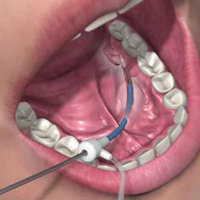Q: What is Salivary Gland Stone?
 |
| Salivary glands, and salivary gland stone |
Salivary stones form when chemicals (mostly Calcium) in the saliva accumulate in the duct or gland.
 |
| A case with big salivary gland stone. |
Q: What are the symptoms?
 |
| A case of salivary gland stone blockage, and forming a lump at the neck area. In this case, it is due to submandibular gland stone |
The stones cause no symptoms as they form, but if they reach a size that blocks the duct, saliva backs up into the gland, causing pain and swelling. You may feel the pain off and on, and it may get progressively worse. Inflammation and infection within the affected gland may follow.
Q:Salivary Gland Stones Diagnosis
If you have symptoms of a salivary gland stone, your doctor will first check for stones with a physical exam. Sometimes tests may also be ordered, such as X-ray, CT scan, or ultrasound.
 |
| A big salivary stone at submandibular saliva gland as shown in the Xray |
Q: What are the treatment?
 |
| Surgery of removing Stone from the saliva duct |
If a stone is detected, the goal of treatment is to remove it. For small stones, stimulating saliva flow by sucking on a lemon or sour candies may cause the stone to pass spontaneously. In other cases where stones are small, the doctor or dentist may massage or push the stone out of the duct.
For larger, harder-to-remove stones, doctors usually make a small incision in the mouth to remove the stone.
 |
| Sialendoscopy is a new approach to remove the stone from the saliva |
More and more, doctors are using a newer and less invasive technique called sialendoscopy to remove salivary gland stones. Developed and used successfully in Europe for a decade, sialendoscopy uses tiny lighted scopes, inserted into the gland's opening in the mouth, to visualize the salivary duct system and locate the stone. Then, using micro instruments, the surgeon can remove the stone to relieve the blockage. The procedure is performed under local or light general anesthesia, which allows the patient to go home right after the procedure.
For people with recurrent stones or irreversible damage to the salivary gland, surgical removal of the gland is necessary.
In addition, antibiotics are prescribed if salivary stones have caused infection.
